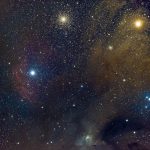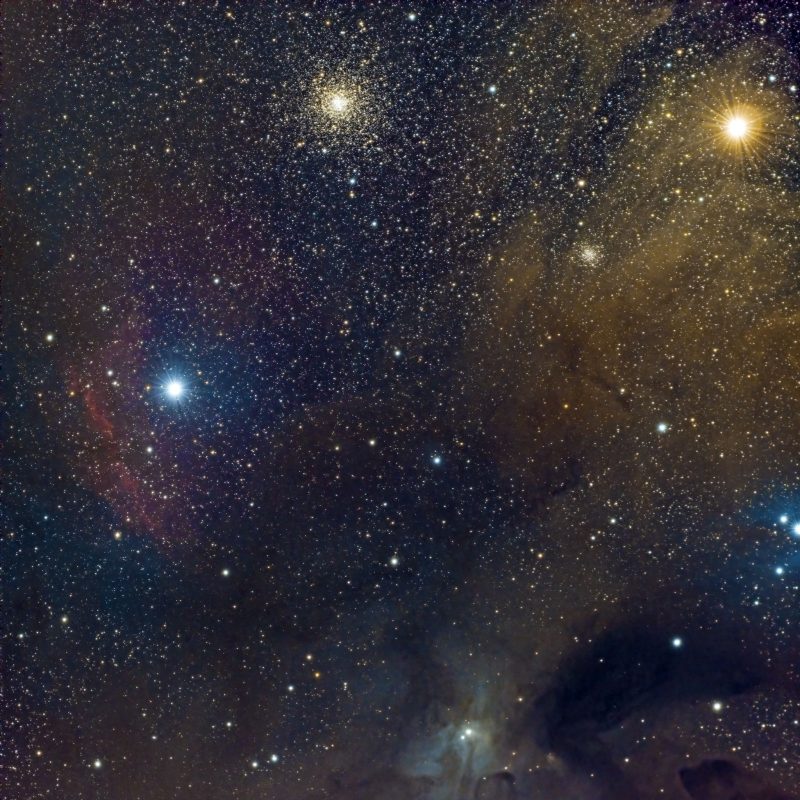

View at EarthSky Community Photos. | Rob Pettengill in Bad Wolf Ranch, Texas, captured this photo of Rho Ophiuchi and environs on March 20, 2021. He wrote: “Lucy in the Sky with Rho Ophiuchi north down with a southern portion of the Rho Ophiuchi star-forming nebula. Antares in the upper right, M4 globular cluster top middle, Al Niyat left of center frame in this spectacularly colorful area of the southern sky. Taken in the early morning of March 20 from Bad Wolf Ranch in central Texas.” Thanks, Rob!
The Rho Ophiuchi cloud complex is one of the most colorful areas of the night sky and a favorite target for astrophotographers. The photo above shows a portion of the Rho Ophiuchi region, which, in its entirety, stretches 4.5 degrees by 6.5 degrees across the dome of the sky. The star Rho Ophiuchi is just out of frame in this image. Across the border from Ophiuchus in the constellation Scorpius, the star Antares shines brightly as a yellow jewel from 550 light-years away. The magnificent globular cluster at top is M4, which is one of the nearest globular clusters to Earth at 7,000 light-years away. The smaller globular cluster between Antares and M4 is named NGC 6144 and is a whopping 33,000 light-years away.
Antares, the brightest star in Scorpius, is nearing the end of its life cycle. The star is beginning to puff off layers of gas, creating its own funeral shroud. To the unaided eye, Antares looks more red than yellow, which is how it earned its name. Antares is considered a rival of reddish Mars, known as Ares in Greek, and Antares was the “Anti-Ares” star.
Al Niyat, or Sigma Scorpii, is the bright bluish star to the left in the above image, with red gas arcing around it. The name Al Niyat is used for two stars, one on each side of Antares. The other Al Niyat is Tau Scorpii and can be seen below Antares in the following image.

View larger. | The yellowish star within the golden cloud is Antares, and the yellowish cluster to its upper right is M4. Al Niyat (Sigma Scorpii) is just above with the reddish arc over it. In this photo taken on February 28, 2015, Saturn is visiting the stars in Scorius’ claws near the top. Photo by Navaneeth Unnikrishnan. Visit Navaneeth on Facebook.
The Rho Ophiuchi region lies along the edge of the Milky Way galaxy as seen from Earth. The Northern Hemisphere gets its best view of Ophiuchus, Scorpius and this general region of the Milky Way during summer months. The farther north you are, the lower the constellation is on your horizon. In places such as Seattle or Stockholm, the entire constellation of Scorpius never clears the horizon.

This image bridges the gap between the close-up view at the top of the page and the wide-field view above. The Rho Ophiuchi region is a colorful area of stars, clusters and nebulae. Image via Rogello Bernal Andreo/ Wikimedia.
This region of sky is notable for its thick concentrations of gas and dust. The black clouds that obscure the background stars are known as dark nebulae. The gas and dust in the Rho Ophiuchi cloud complex supports a star-forming region a mere 460 light-years away, making it one of the closest known star-forming regions to Earth. Enough material lies in this star-forming region to create the equivalent of 3,000 suns.
The actual star Rho Ophiuchi, which gives its name to this region, can be seen in the last image. Just right of center in the image is a star enveloped in a large blue cloud. This is the double star Rho Ophiuchi, a not-particularly bright pair that shines at magnitude 4.6. The star would be two magnitudes brighter if not for the dusty clouds that obscure it. Reflection nebula is the name for the bright bluish halo extending around Rho Ophiuchi. The dark nebulae that streak out around Rho Ophiuchi extend for 100 light-years into Sagittarius to the east. One day these dusty clouds of gas will disappear as bright new stars radiate from this region of space.
Bottom line: The Rho Ophiuchi region of sky contains an abundance of beautiful gems.
from EarthSky https://ift.tt/3dhr5u6


View at EarthSky Community Photos. | Rob Pettengill in Bad Wolf Ranch, Texas, captured this photo of Rho Ophiuchi and environs on March 20, 2021. He wrote: “Lucy in the Sky with Rho Ophiuchi north down with a southern portion of the Rho Ophiuchi star-forming nebula. Antares in the upper right, M4 globular cluster top middle, Al Niyat left of center frame in this spectacularly colorful area of the southern sky. Taken in the early morning of March 20 from Bad Wolf Ranch in central Texas.” Thanks, Rob!
The Rho Ophiuchi cloud complex is one of the most colorful areas of the night sky and a favorite target for astrophotographers. The photo above shows a portion of the Rho Ophiuchi region, which, in its entirety, stretches 4.5 degrees by 6.5 degrees across the dome of the sky. The star Rho Ophiuchi is just out of frame in this image. Across the border from Ophiuchus in the constellation Scorpius, the star Antares shines brightly as a yellow jewel from 550 light-years away. The magnificent globular cluster at top is M4, which is one of the nearest globular clusters to Earth at 7,000 light-years away. The smaller globular cluster between Antares and M4 is named NGC 6144 and is a whopping 33,000 light-years away.
Antares, the brightest star in Scorpius, is nearing the end of its life cycle. The star is beginning to puff off layers of gas, creating its own funeral shroud. To the unaided eye, Antares looks more red than yellow, which is how it earned its name. Antares is considered a rival of reddish Mars, known as Ares in Greek, and Antares was the “Anti-Ares” star.
Al Niyat, or Sigma Scorpii, is the bright bluish star to the left in the above image, with red gas arcing around it. The name Al Niyat is used for two stars, one on each side of Antares. The other Al Niyat is Tau Scorpii and can be seen below Antares in the following image.

View larger. | The yellowish star within the golden cloud is Antares, and the yellowish cluster to its upper right is M4. Al Niyat (Sigma Scorpii) is just above with the reddish arc over it. In this photo taken on February 28, 2015, Saturn is visiting the stars in Scorius’ claws near the top. Photo by Navaneeth Unnikrishnan. Visit Navaneeth on Facebook.
The Rho Ophiuchi region lies along the edge of the Milky Way galaxy as seen from Earth. The Northern Hemisphere gets its best view of Ophiuchus, Scorpius and this general region of the Milky Way during summer months. The farther north you are, the lower the constellation is on your horizon. In places such as Seattle or Stockholm, the entire constellation of Scorpius never clears the horizon.

This image bridges the gap between the close-up view at the top of the page and the wide-field view above. The Rho Ophiuchi region is a colorful area of stars, clusters and nebulae. Image via Rogello Bernal Andreo/ Wikimedia.
This region of sky is notable for its thick concentrations of gas and dust. The black clouds that obscure the background stars are known as dark nebulae. The gas and dust in the Rho Ophiuchi cloud complex supports a star-forming region a mere 460 light-years away, making it one of the closest known star-forming regions to Earth. Enough material lies in this star-forming region to create the equivalent of 3,000 suns.
The actual star Rho Ophiuchi, which gives its name to this region, can be seen in the last image. Just right of center in the image is a star enveloped in a large blue cloud. This is the double star Rho Ophiuchi, a not-particularly bright pair that shines at magnitude 4.6. The star would be two magnitudes brighter if not for the dusty clouds that obscure it. Reflection nebula is the name for the bright bluish halo extending around Rho Ophiuchi. The dark nebulae that streak out around Rho Ophiuchi extend for 100 light-years into Sagittarius to the east. One day these dusty clouds of gas will disappear as bright new stars radiate from this region of space.
Bottom line: The Rho Ophiuchi region of sky contains an abundance of beautiful gems.
from EarthSky https://ift.tt/3dhr5u6

Aucun commentaire:
Enregistrer un commentaire